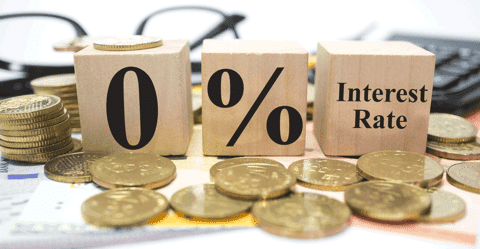A great choice is a credit card with 0% interest for 15 months or more. Even though you have to make the minimum payments, they can be one of the best ways to get rid of debt or pay for unexpected expenses if you use them strategically. Even though credit card interest rates are notoriously high compared to other types of loans, some credit cards offer promotional 0% APR periods during which the cardholder doesn’t have to pay interest on either new purchases or balance transfers. This article will unveil all you should know about the best no-interest credit cards for 2023.
Overview
With a credit card that gives you a zero percent introductory APR, you can buy things without paying interest for a certain amount of time. During the introductory period, the best cards won’t charge interest on fee-based balance transfers. If money is tight for you, this card could save your life. A recent survey by TransUnion found that the average consumer owes more than $5,000 on their credit cards and has no savings at all.
The APR is the annual percentage rate your credit card company will charge you for any balance you have. For different types of spending, different credit cards have different interest rates (purchases, cash advances, etc.). Your credit card statement details your annual percentage rate.
There are no credit cards out there with an annual percentage rate (APR) of 0% or an interest rate of “0%.” Instead, it tells you that the card comes with a promotional period with 0% APR. On purchases, debt transfers, or both, the introductory APR is often 0%, but not on cash advances.
Read Also: REFINANCING AN AUTO LOAN: How It Works, Best Credit Cards & Ideas
The prime rate is the interest rate that big banks charge their best customers. Most issuers set their rates a certain number of percentage points higher than the prime rate. Your annual percentage rate (APR) will be 17.5 percent if the prime rate is 5.5 percent and your rate is “prime plus 12 points.” The annual percentage rate (APR) of a credit card will never be less than the prime rate, except during promotional periods with 0% or very low “teaser” rates.
Even though interest rates are given on an annual basis, most lenders really charge interest every day. For example, if the rate was 19.25% per year, it would be about 0.0535% per day. For every $1,000 you owe, that’s about $0.54 a day in interest costs. Even if it doesn’t seem like much right now, that amount can make a big difference in a month or a year. Some of the best credit cards with no interest are listed below:
#1. BankAmericard Credit Card
BankAmericard isn’t trying to make a big splash, so don’t expect any features that will make you stand out. If you need more time to pay off debt or save up for a big purchase, your introductory 0% APR period is one of the longest available anywhere.
#2. The Visa® Wells Fargo® Reflect Card
If you make your monthly minimum payments on time, your Wells Fargo Reflect Card’s introductory 0% APR period could last for almost two years. You won’t often find such a low introductory rate for either new purchases or balance transfers.
#3. Chase Slate Edge
The Chase Slate Edge, which doesn’t have an annual fee and doesn’t look like much, has a great introductory 0% APR period on purchases and balance transfers and may offer other rewards for making payments on time.
#4. Bank of America Travel Rewards Credit Card
The Bank of America Travel Rewards credit card is one of the best no-annual-fee travel cards because it offers a good rewards rate on all purchases and points that can be used for any travel transaction, unlike branded airline and hotel cards. Bank of America has a broad definition of the word “travel,” which gives you more ways to spend your rewards.
#5. Citi Custom Cash Card
The Citi Custom Cash Card doesn’t have an annual fee, but you can get 5% cash back on up to $500 in purchases in your favorite category each billing cycle, or 1% cash back on all other purchases. The 5% discount can be used at a wide range of businesses, such as restaurants, grocery stores, and more. Unlike its competitors, you don’t have to keep track of an activation period or a bonus calendar.
#6. Credit Card with Unlimited Bank of America Cash Rewards
The Bank of America Unlimited Cash Rewards credit card is one of several that offer a flat 1.5% cash-back rate. With Bank of America’s Preferred Rewards program, you can make more money and get a great sign-up bonus at the same time.
#7. American Express’s Blue Cash Everyday Card
The American Express Blue Cash Everyday Card gives you bonus rewards when you use it at U.S. grocery stores, gas stations, or online stores. This card is different from the American Express Blue Cash Preferred Card in that it doesn’t have an annual fee, but the benefits aren’t as good. The introductory 0% APR period and the welcome offer are both good for people who are getting their first credit card.
#8. Chase Flex Freedom
The Chase Freedom Flex gives you bonus cash back when you eat out, buy groceries, or buy medicine. It also gives you bonus cash back when you book travel through Chase and when you buy things in quarterly bonus areas that you activate. Even though turning on categories might be a pain, you could save hundreds of dollars a year if your shopping habits are similar to those of the categories. There is a great bonus for new customers, and the introductory APR is 0%.
#9. Discover It Cash Back
The Discover it Cash Back card gives you more cash back in categories that you choose every three months. In the past, grocery stores, restaurants, gas stations, and online stores like Amazon were common examples. Even though turning on categories can be a hassle, the benefits are worth it if your spending habits fit those categories (which they will for most households). The well-known “cash-back match” bonus from the issuer is also given in the first year.
#10. Bank of America Personalized Cash Rewards credit card
With the Bank of America Personalized Cash Rewards credit card, you can choose the category with the best cash-back rate. This gives you a little more control over your credit card rewards. This includes gas stations, restaurants, travel, home improvements, and more. In addition to the great welcome bonus, you can get extra rewards at grocery stores and supermarkets.
How Exactly Does Interest Add Up on a Credit Card?
To borrow money from a person or an institution, you must pay interest. If you pay off your credit card balance in full each month, you won’t be charged interest on any purchases you make. The following below is how interest adds up on a credit card:
- If you carry a balance from one billing cycle to the next, interest will start to be added after the grace period is over. The APR of your card is used to figure out how much interest you have to pay.
- If you are more than 60 days late with your payment, you may also have to pay a penalty APR. The best-case scenario would be a low APR, which could be different for purchases and balance transfers.
Before the card’s normal or continuous APR starts, a credit card’s introductory 0% APR period is a great way to save money. During the introductory 0% APR period, you could buy something new or transfer a balance, or you could do both.
After a promotional APR period ends, you usually pay an ongoing APR, which can change based on market conditions. Organizations like the Federal Reserve can affect whether or not a bank raises or lowers the interest rates on credit cards.
How Do Deals With 0% Apr Work?
Many credit card companies offer 0% intro APR or interest-free financing for the first few months after an account is opened. Credit card companies often offer this 0% APR deal for 12 to 21 months.
Most of the time, there are no fees or costs to start this kind of promotion, but keep in mind that it won’t last forever. After the introductory 0% APR period is over, interest will be added to your credit card balance at the standard rate, which is between 16 and 29 percent at the moment, plus any other fees or penalties (such as late payments).
With a credit card that has a 0% intro APR promotion, you can put big expenses like a home renovation or a vacation on layaway and pay for them over time without paying interest. The average interest rate on credit cards is about 20%, which is quite high.
How to Pick a Credit Card with No Interest Rate
The following is how to choose a credit card with no interest or an annual fee:
#1. Try to Find the 0% Interest Rate Deal That Lasts the Longest
Make sure that the plan you’re thinking about gives you enough time to pay off all or most of your debt without paying any interest.
#2. Know the Price
If you think you can pay off your debt in a reasonable amount of time, you should look for credit cards with 0% APR and no balance transfer fees.
#3. Think About What Rewards You Want the Most
Think about whether the extra features of your credit card, like getting your FICO score for free on your monthly statement, are worth the extra cost to you.
#4. Don’t Just Buy Something Without Giving It Some Thought
Think about the kinds of purchases you plan to make if you want to get the most rewards and pay the least amount of interest. You should choose a card that gives you the most rewards for the money you spend. Some cards give more rewards in some bonus categories than in others.
#5. Watch the Yearly Percentage Rate (Apr)
Remember that the introductory APR on a debt transfer credit card may be lower than the ongoing APR, but it will eventually go back to the introductory rate.
Review of the Pros and Cons of Credit Cards With No Annual Percentage Rate
We’ll talk about the pros and cons of using the best credit cards with no interest below.
Pros
#1. Time as a Gift
Credit cards with 0% interest rates are made to help you pay off a big debt over a longer period of time. The best first offers are ones that last for at least 18 months.
#2. Lowered Interest Costs
With an introductory APR of 0% for the first year on both purchases and debt transfers, you might be able to save a lot of money.
#3. Regular Payments Are Cut
During the introductory period, being able to pay over a longer period of time could help keep costs at a manageable level.
#4. Credit Scores Could Get Better in the Long Run
Taking care of your debts in a responsible way can help your credit score and show lenders that you are a low-risk borrower.
Cons
#1. Not Paying What You Owe
Not being able to pay during the introductory APR period. Your new credit card issuer may apply the normal APR if you don’t follow the 0% APR rules.
#2. Impact on Credit Score
Your credit score will go down because you have to do a hard credit check to get a new credit card. After a year, hard searches don’t show up on credit reports anymore.
Which Credit Card Is Best Without Interest?
The following are;
- With Scover it, you can shop with confidence and earn cash back.
- With the Wells Fargo Active Cash® Card, you get the most cash back at a flat rate.
- The Capital One SavorOne Cash Rewards Credit Card is great for use at restaurants and theaters.
- Citi Simplicity® Card is best for no late fee.
Can You Get 0% Interest on Credit Cards?
Credit cards that don’t charge interest for a certain amount of time (usually between six and twenty-one months) are very appealing. Depending on the card, there may be an initial period where neither purchases nor balance transfers incur interest.
What Credit Card Offers 18 Months of No Interest?
The following are;
- U.S. Visa® Card from Platinum Bank.
- BankAmericard® gives out credit cards.
- Using Discover it®, you can move your balance.
- Citi® Easy-to-Use Card.
- Card from Citi that gives you twice as much cash back.
- The Citi® Diamond Preferred® Card.
- BankAmericard® gives out credit cards.
Which Bank Credit Card Is Lifetime Free?
If you don’t mind paying an annual fee, the HSBC Visa Platinum Credit Card may be good for you if you do a lot of shopping or travel. You’ll get cash back and movie tickets if you spend enough.
How Long Can You Have a Credit Card Without Interest?
The Credit CARD Act of 2009 says that creditors must give customers at least 21 days after the end of a billing cycle (the end of the month) to pay off their credit card balances in full without being charged interest.
What Happens if I Get a Credit Card and Never Use It?
If you haven’t used your credit card account in a while, the company may close it. If you don’t check your credit card statement frequently, you can miss fraudulent charges. However, if you don’t use your credit card, the company could close your account. This could hurt your credit score.
Conclusion
Low-interest credit cards can save you money over time because they make it easier to pay off your debt. Use a card with a 0% introductory APR offer to save the most on interest in the short term. Check to see if there’s an introductory period with no interest for more than a year. If you often carry a balance from month to month, a card with a low ongoing interest rate will help you in the long run. Be wary of 0% APR credit cards that don’t offer other benefits, like incentives and special access, because they may not be worth it after the promotional period ends.
- What Is A Balance Transfer Fee? How It Works
- What Is A Good Interest Rate On A Credit Card? (Updated)
- WHAT IS APR: How it works
- $2000 LOANS: What to Know About Getting a $2000 Loan With No Credit Check






